The Bicycle
One of the 100 Greatest Inventions
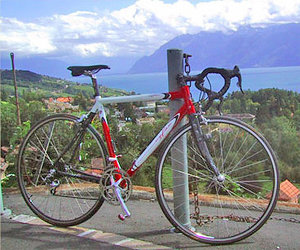
This racing bicycle is built using lightweight, shaped aluminum tubing and carbon.. It sports a drop handlebar and thin tires and wheels for efficiency and aerodynamics
Bicycle -- History -- Types of Bikes
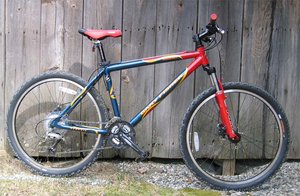
A bicycle, or bike, is a pedal-driven land vehicle with two wheels attached to a frame one behind the other. First introduced in 19th-century Europe, it evolved quickly into its current design. With over one billion in the world today, bicycles provide the principal means of transportation in many regions and a popular form of recreation in others.
The bicycle has impacted history considerably, in both the cultural and industrial realms. In its early years, bicycle construction drew on pre-existing technologies, while more recently bicycle technology has contributed in turn to other, newer areas. Beyond recreation and transportation, bicycles have been adapted for use in many occupations, in the military, and in sports as well. A recurring theme in bicycling has been the tension between bicyclists and drivers of motor vehicles, each of whom argue for their fair share of the world's roadways.
History
No single time or person can be identified with the invention of the bicycle. Its earliest known forebears were called velocipedes, and included many types of human powered vehicles. One of these, the scooter-like dandy horse of the French Compte de Sivrac, dating to 1790, was long cited as the earliest bicycle. Most bicycle historians now believe that these unsteerable hobby-horses probably never existed, but were made up by Louis Baudry de Saunier, a 19th century French bicycle historian.
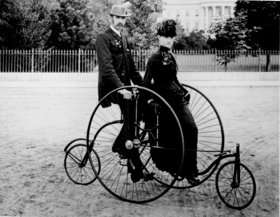
The most likely originator of the bicycle is German Baron Karl von Drais, who rode his 1816 machine while collecting taxes from his tenants. He patented his draisine, a number of which still exist, including one in the Paleis het Loo museum in Apeldoorn, the Netherlands. These were pushbikes, powered by the action of the rider's feet pushing against the ground. Scottish blacksmith Kirkpatrick MacMillan shares creator's credit with von Drais, for adding a treadle drive mechanism, in 1840, which enabled the rider to lift his feet off the ground while driving the rear wheel.
In the 1850s and 1860s, Frenchman Ernest Michaux and his pupil Pierre Lallement took bicycle design in a different direction, placing pedals on an enlarged front wheel. Their creation featured a heavy steel frame on which they mounted wooden wheels with iron tires. Lallement emigrated to America, where he recorded a patent on his bicycle in 1866. The invention was further refined by James Starley in the 1870s. He mounted the seat more squarely over the pedals, so that the rider could push more firmly, and further enlarged the front wheel to increase the potential for speed. Shod with solid rubber tires, his machine became known as the ordinary. British cyclists likened the disparity in size of the two wheels to their coinage, nicknaming it the penny-farthing. The primitive bicycles of this generation were difficult to ride, and the high seat and poor weight distribution made for dangerous falls.
The subsequent dwarf ordinary addressed some of these faults, by adding some kind of gearing, reducing the front wheel diameter and setting the seat further back with no loss of speed. However, having to both pedal and steer via the front wheel remained a problem. Starley's nephew, J. K. Starley, J. H. Lawson, and Shergold solved this problem by introducing the chain and producing rear-wheel drive. These models were known as dwarf safeties, or safety bicycles, for their lower seat height and better weight distibution. Starley's 1885 Rover is usually described as the first recognisably modern bicycle. Soon the seat tube was added, creating the double-triangle, diamond frame of the modern bike. These vehicles were often refered to as 'Boneshakers' as the smaller wheel circumference made for a much harder ride on the poor road surfaces of the time unlike the Ordinaries whose larger wheels smoothed out the bumps considerably.
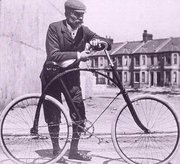
While the Starley design was much safer, the return to smaller wheels made for a bumpy ride. The next innovations increased comfort and ushered in the 1890s Golden Age of Bicycles. In 1888 Scotsman John Boyd Dunlop introduced the pneumatic tire, which soon became universal. Shortly thereafter the rear freewheel was developed, enabling the rider to coast without the pedals spinning out of control. This refinement led to the 1898 invention of coaster brakes. Derailleur gears and hand-operated, cable-pull brakes were also developed during these years, but were only slowly adopted by casual riders. By the turn of the century, bicycling clubs flourished on both sides of the Atlantic, and touring and racing were soon the rage.
Successful early bicycle manufacturers included Englishman Frank Bowden and German builder Ignaz Schwinn. Bowden started the Raleigh company in Nottingham in the 1890s, and soon was producing some 30,000 bicycles a year. Schwinn emigrated to the United States, where he founded his similarly successful company in Chicago in 1895. Schwinn bicycles soon featured widened tires and spring-cushioned, padded seats, sacrificing some efficiency for increased comfort. Facilitated by connections between European nations and their overseas colonies, European-style bicycles were soon available worldwide. By the mid-20th century bicycles had become the primary means of transportation for millions of people around the globe.
In many western countries the use of bicycles leveled off or declined, as motorized transportation became affordable and car-centered policies led to an increasingly hostile road environment for bicycles. In North America, bicycle sales declined markedly after 1905, to the point where by the 1940's they had largely been relegated to the role of children's toys. In other parts of the world however, such as China, India and European countries such as Germany, Denmark, and the Netherlands, the traditional utility bicycle remained a mainstay of transportation, its design only gradually changing to incorporate hand-operated brakes and internal hub gears allowing up to seven speeds.
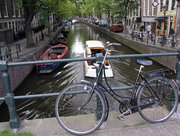
In North America, increasing consciousness of physical fitness and environmental preservation spawned a renaissance of bicycling in the late 1960s. Bicycle sales in the United States boomed, largely in the form of the racing bicycles long used in such events as the hugely popular Tour de France. Sales were also helped by a number of technical innovations that were new to the US market, including higher performance steel alloys and gearsets with an increasing number of gears. While 10-speeds were the rage in the 1970s, 12-speed designs were introduced in the 1980s, and today most bikes feature 18 or more speeds. By the 1980s these newer designs had driven the three-speed bicycle from the roads. In the late 1980s the mountain bike became particularly popular, and in the 1990s something of a major fad. These specialized designs led many American recreational cyclists to demand a more comfortable and practical product. Manufacturers responded with the hybrid bicycle, which restored many of the features long enjoyed by riders of the time-tested European utility bikes.
Legal requirements
The Vienna Convention on Road Traffic considers a bicycle to be a vehicle, while a person controlling a bicycle is considered a driver. The traffic codes of many countries reflect these definitions and demand that a bicycle satisfy certain legal requirements, including licencing, before it can be used on public roads. In many jurisdictions it is an offence to use a bicycle that is not in roadworthy condition and which does not have functioning front and rear brakes. In some places, bicycles must have functioning front and rear lights or lamps. As some generator or dynamo-driven lamps only operate while moving, rear reflectors are frequently also mandatory. Since a moving bicycle makes very little noise, in many countries bicycles must have a warning bell for use when approaching pedestrians, equestrians and other bicyclists.
Construction and parts
Frame
>Nearly all modern upright bicycles feature the diamond frame, composed of two triangles: the front triangle and the back triangle. The front triangle consists of the head tube, top tube, down tube and seat tube. The head tube contains the headset, the interface with the fork. The top tube connects the head tube to the seat tube at the top, and the down tube connects the head tube to the bottom bracket. The rear triangle consists of the seat tube and paired chain stays and seat stays. The chain stays run parallel to the chain, connecting the bottom bracket to the rear dropouts. The seat stays connect the top of the seat tube (often at or near the same point as the top tube) to the rear dropouts.
Historically, women's bicycle frames had a top tube that connected in the middle of the seat tube instead of the top, resulting in a lower standover height. This allowed the rider to dismount while wearing a skirt or dress. Although some women's bicycles continue to use this frame style, there is also a hybrid form, the mixte or step-through frame, which also allows easier mounting and dismounting for both male and female riders.
Historically, materials used in bicycles have followed a similar pattern as in aircraft, the goal being strength and low weight. Since the late 1930s alloy steels have been used for frame and fork tubes in higher quality machines. Celluloid found application in mudguards, and aluminum alloys are increasingly used in components such as handle bars, seat stems, and brake levers. In the 1980s aluminum alloy frames became popular, and their affordability makes them still common. More expensive carbon fibre and titanium frames are now also available, as well as advanced steel alloys.
Drivetrain
The drive train begins with pedals which rotate the crankset which fit into the bottom bracket. Attached to the crank is the chainring which drives the chain, which in turn rotates the rear wheel via the rear sprockets. Between the chain and rear wheel may be interspersed various gearing systems, described below, which vary the gear ratio, the number of rear wheel revolutions produced by each turn of the pedals.
Since cyclists' legs produce limited power and produce power most efficiently over a narrow range of cadences, a variable gear ratio is needed to maintain an optimum pedaling speed while covering varied terrain. The gear systems are hand-operated, via cables, and are of two types. Internal hub gearing works by planetary, or epicyclic, gearing, in which the outer case of the hub gear unit turns at a different speed relative to the rear axle depending on which gear is selected. External gearing utilizes derailleurs, which can be placed on both the front chainring and on the rear cluster or cassette, to push the chain to either side, derailing it from the sprockets. The sides of the gear rings catch the chain, pulling it up onto their teeth to change gears. Road bicycles have close set multi-step gearing, which allows very fine control of cadence, while utility cycles offer fewer, more widely spaced speeds. Mountain bikes may offer an extremely low gear to facilitate climbing slowly on steep hills. Internal hub gearing still predominates in some regions, particularly on utility bikes, whereas in other regions external derailleur systems predominate.
Steering and seating
The handlebars rotate the fork and the front wheel via the stem, which articulates with the headset. Three styles of handlebar are common. Touring handlebars, the norm in Europe and elsewhere until the 1970s, curve gently back toward the rider, offering a natural grip and comfortable upright position. Racing handlebars are "dropped", offering the cyclist either an aerodynamic "hunched" position or a more upright posture in which the hands grip the brake lever mounts. Mountain bikes feature a crosswise handlebar, which helps prevent the rider from pitching over the front in case of sudden deceleration.
Variations on these styles exist. The Bullhorn style handlebars are often seen on modern Time Trial specific bicycles, equipped with two forward-facing extensions, allowing a rider to rest his entire forearm on the bar. These are usually used in conjunction with the aero bar, a pair of forward-facing extensions spaced close together, to allow the rider a position of increased aerodynamics.
Seats, or saddles, also vary depending on rider preference, from the cushioned ones favored by short-distance riders to narrower seats which allow more free leg swings. Comfort depends on riding position. With comfort bikes and hybrids the cyclist sits high over the seat, their weight directed down onto the saddle, such that a wider and more cushioned saddle is preferable. For racing bikes where the rider is bent over, weight is more evenly distributed between the handlebars and saddle, and the hips are flexed. For this style of riding a narrower and harder saddle is more efficient.
Brakes
Bicycle brakes are either rim brakes, in which friction pads are compressed against the wheel rims, or internal hub brakes, in which the friction pads are contained within the wheel hubs. A rear hub brake may be either hand-operated or pedal-actuated, as in the back pedal coaster brakes which were the rule in North America until the 1960s. Hub brakes do not cope well with extended braking, so rim brakes are favoured in hilly terrain. With hand-operated brakes, force is applied to brake handles mounted on the handle bars and then transmitted via Bowden cables to the friction pads. In the late 1990s, disc brakes appeared on some off-road bicycles and on tandems, but are considered impractical on road bicycles, which rarely encounter conditions where the advantages of discs are significant.
Accessories and repairs
Utility bicycles have many standard features which enhance their usefulness and comfort that would be considered accessories on sports bicycles. Chainguards and mudguards, or fenders, protect clothes and moving parts from oil and spray. Kick stands help with parking. Front-mounted wicker or steel baskets for carrying goods are often used. Rear racks or carriers can be used to carry items such as school satchels. Parents sometimes add rear-mounted child seats and/or an auxiliary saddle fitted to the crossbar to transport children.
Other accessories include lights, pump, lock, and additional (pedal or wheel-mounted) reflectors. Technical accessories include solid-state speedometers and odometers for measuring distance. Toe-clips help to keep the foot planted firmly on the pedals, and enable the cyclist to pull as well as push the pedals.
In North America, a large minority, possibly up to 25% in the US, of bicyclists wear plastic bicycle helmets for safety. There is no US federal law requiring the use of helmets, but the majority of states require children up to a certain age to wear them; a number of cities and counties in Washington require them for riders of all ages. In Australia and New Zealand, and parts of Canada, such helmets are required by law. The use of helmets by utility cyclists is practically unknown in most other regions. In most European countries, helmets are viewed as an indicator of inexperience or recklessness, and their use is considered unusual for adult utility cyclists.
Many cyclists also carry tool kits, containing at least a patch kit for tires and some spanners. At one time it was possible to use a single tool to carry out most common bicycle repairs. More specialised parts now often require more complex tools, including proprietary tools specific for a given manufacturer. Some bicycle parts, particularly hub-based gearing systems, are complex, and many people prefer to leave most maintenance and repairs to professionals. Others maintain their own bicycles, finding it enhances their enjoyment of the hobby of cycling.
Performance
In both biological and mechanical terms, the bicycle is extraordinarily efficient. In terms of the number of calories of energy a person must expend to travel a given distance, investigators have calculated it to be the most efficient self-powered means of transportation.1 From a mechanical viewpoint, engineers studying the efficiency of the chain drive mechanism have also determined that more than 98% of the energy delivered by the rider into the pedals is transmitted to the wheels, with less than 2% sacrificed to friction.2 In terms of the ratio of cargo weight a bicycle can carry to total weight, it is also a most efficient means of cargo transportation.
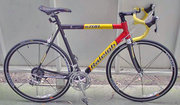
An average cyclist at 30 km/h (a good road pace) will burn about 450 calories per hour, or about 15 calories per kilometer. In contrast, walking at 5 km/h requires about 285 calories per hour (for a 160lb male), or 57 calories per kilometer, about four times as much. Generally used figures are 0.28 calories/mile/pound for cycling, 0.653 for walking/running, and 2.93 for swimming. Compared to running, cycling requires a longer time to consume the same number of calories. On the other hand, cycling is a "no-impact" sport that is easier on the body, as long as the bike is properly "fit". For many people whose running might be limited by muscle and knee pain, cycling offers a similar outdoor exercise that can be enjoyed by people of a wide range of fitness levels.
There has been major corporate competition to lower the weight of racing bikes through the use of advanced materials and components. Additionally, advanced wheels are available with low-friction bearings and other features to lower road resistance. In measured tests these components have almost no effect on cycling performance. For instance, lowering a bike's weight by 1 kg, a major effort considering they may weigh less than 15 kg to start with, will have the same effect over a 40 km time trial as removing a protrusion into the air the size of a pencil. For this reason more recent designs have concentrated on lowering wind resistance, using aerodynamically shaped tubing, flat spokes on the wheels, and handlebars that allow the rider to bend over into the wind. These changes can impact performance dramatically, cutting minutes off a time trial.
The average "in-shape" adult human male can produce about 250 watts (1/3rd horsepower) continuously, with elite athletes increasing this significantly. More notable is the burst power of athletes, who can deliver over 700 watts for extended periods while climbing. Some are able to deliver up to 2,000 watts of power to the rear wheel for short-duration sprints. Women of the same level of training produce slighly less power. In terms of power-to-weight ratio women are noticably better than men. Cycling energy is dominated almost entirely by drag, which requires power to overcome. This is the reason competitive cycling is dominated by men, as overcoming drag requires raw power. Women do comparatively better in climbing events, where body mass becomes an important consideration.
Typical speeds for bicycles are 16 to 32 km/h (10 to 20 mph). On a fast racing bicycle, a reasonably fit rider can ride at 50 km/h (30 mph) on flat ground for short periods. The highest speed ever officially attained on the flat, without using motor pacing and wind-blocks, is by Canadian Sam Whittingham, who in 2002 set a 130.36 km/h (81.00 mph) record on his highly aerodynamic recumbent bicycle. This stands as the official record for all human-powered vehicles.
Bicycle physics
A rider stays upright on a bicycle by steering the bicycle so that the point where the wheels touch the ground stays underneath the center of gravity. Once underway, this effort is largely replaced by physical forces generated by the rotation of the wheels which produce a remarkable "self-steering" effect.3 The angular momentum of the wheels and the torque applied to them by the ground generates a phenomenon called precession, by which the wheel turns, or trails, toward whichever side to which the bicycle tilts. Like the rider's steering adjustments, this motion automatically returns the contact point of the wheel directly under the center of gravity. These forces, perhaps aided at very high speeds by the gyroscopic effect of the spinning wheels,4 are sufficiently strong that a riderless bicycle going down a slope will stay upright by itself. Conversely, a bicycle whose steering fork is locked in a perfectly straight ahead position is virtually impossible to balance.
That gyroscopic effects are unimportant at normal cycling speeds was shown by physicist and researcher into bicycle stability David E. H. Jones, whose series of "URBs" ("unrideable bikes" with various modifications to the front end) included a bike which cancelled the gyroscopic effect of the front wheel by dint of attaching a second wheel to his front forks (alongside the regular wheel) whose lower edge was about an inch (25 mm) above the ground. By gearing this wheel to the regular front wheel so that it spun in the opposite direction at equal speed, the net angular momentum of both wheels together was close to zero. Jones found he could ride this bike with no difficulty, but did discover that without a rider the non-gyroscopic bike fell over much faster than a regular bike.
Stability is also influenced by a geometric factor called trail. This is the distance between the point of contact the front wheel makes with the ground and the place the steering axis makes contact with the ground. The greater the amount of trail, the greater the reaction. One can see the effect that trail has by simply holding a bicycle by the seat and leaning it. The moment due to trail and the weight of the bicycle will turn the front wheel in the direction of the turn. Negative trail (rolling a bicycle backwards) results in immediate steering problems. Zero trail (as in a unicycle) requires constant rider adjustment. Positive trail - found on typical bicycles - creates positive stability by steering the contact patch back under the CG of the bicycle and rider. [1]
At higher speeds bicycles can also experience speed wobbles or shimmies, where the front wheel spontaneously oscillates to the left and right. While the wobbles can be easily remedied by slowing down or adjusting position, speed wobbles can be fatal (http://www.mailtribune.com/archive/2004/0915/local/stories/01local.htm)
This shimmy is often seen in shopping cart front wheels. Some otherwise minor irregularity accelerates the wheel to one side. The restoring force is applied in phase with the progress of the irregularity, and the wheel turns to the other side where the process is repeated. If there is insufficient damping in the steering the oscillation will increase until system failure. Speed changes, making the bicycle/motorcycle stiffer or lighter, or increasing the stiffness of the steering (of which the rider is the main component) can change the oscillation frequency, though only speed change is applicable in the situation.
Economic and social implications
Bicycle manufacturing proved to be a training ground for other industries. Building modern bicycle frames led to the development of advanced metalworking techniques, both for the frames themselves and for special components such as ball bearings, washers, and sprockets. These techniques later enabled skilled metalworkers and mechanics to develop the components used in early automobiles and aircraft. J. K. Starley's company became the Rover Cycle Company Ltd. in the late 1890s, and then the Rover auto maker. The Morris Motor Company and Skoda also began in the bicycle business, as did Henry Ford and the Wright Brothers.
In recent years, US and European bicycle makers have moved much of their production to Asia. Some sixty percent of the world's bicycles are now being made in China. Despite this shift in production, as nations such as China and India become more wealthy, their own use of bicycles has declined. One of the major reasons for the proliferation of Chinese-made bicycles in foreign markets is the increasing affordability of cars and motorcycles for its own citizens 5.
Bicycle racing
Shortly after the introduction of bicycles, competitions developed independently in many parts of the world. Early races involving boneshaker style bicycles were predictably fraught with injuries. Large races became popular during the 1890's "Golden Age of Cycling", with events across Europe, and in the U.S. and Japan as well. Paris-Brest-Paris (PBP), which began in 1891, is the oldest bicycling event still run on a regular basis on the open road, covers over 1200 km and imposes a 90-hour time limit. The most famous of all bicycle races, and perhaps the most well-known race of any type, the Tour de France began in 1903, and continues to capture the attention of the sporting world.
As the bicycle evolved its various forms, different racing formats developed. Road races may involve both team and individual competition, and are contested in various ways. They range from the one-day road race, criterium, and time trial to multi-stage events like the Tour de France and its sister events which make up cycling's Grand Tours. Velodromes host short course track cycling which features mostly fixed-gear bicycles, while cyclo-cross races are held on rugged outdoor terrain. In the past decade, mountain bike racing has also reached international popularity and is even an olympic sport.
Types of bicycle
There are many different types of bicycle. See also Category:Cycle types.
- By function
- Mountain bicycles are designed for off-road cycling. They combine relatively light weight with durability, and feature wide-gauge treaded tires, cross-wise handlebars to help the rider resist sudden jolts, and sometimes coiled-spring suspension systems.
- Road bicycles include racing, touring, and other types of bicycles suited primarily for riding on paved surfaces.
- Racing bicycles are designed for speed. They have lightweight frames and components with minimal accessories, dropped handlebars to allow for an aerodynamic riding position, narrow high-pressure tires for minimal rolling resistance, and derailleur gears offering a wide variety of speeds.
- Touring bicycles are designed for bicycle touring and long journeys. They are durable and comfortable, capable of transporting baggage, and may feature any type of gearing system.
- Utility bicycles are designed for commuting, shopping and running errands. They are the norm in Europe, and employ middle or light weight frames and tires, internal hub gearing, and a variety of helpful accessories.
- By number of riders
- A tandem or twin has two riders.
- A triplet has three riders; a quadruplet has four.
- The largest multi-bike had 40 riders.
In most of these types the riders ride one behind the other. Exceptions are "The Companion" or 'sociable,' a side by side tandem (that converted to a single rider) built by the Punnett Cycle Mfg. Co. in Rochester, N. Y. in the 1890s. Another bicycle rented to tourists in Berlin has 8 people seated in a circle.
- By general construction
- A penny-farthing or ordinary has one high wheel directly driven by the pedals and one small wheel.
- On an upright bicycle the rider sits astride the saddle. This is the most common type.
- On a recumbent bicycle the rider reclines or lies supine.
- A Pedersen bicycle has a bridge truss frame.
- A folding bicycle can be quickly folded for easy carrying, for example on public transport.
- A Moulton Bicycle has a traditional seating position, and utilises small diameter, high pressure tires and front and rear suspension.
- An exercise bicycle remains stationary; it is used for exercise rather than propulsion.
- By gearing
- Internal hub gearing is still most common in European bicycles, usually ranging from three-speed bicycles to five and seven speed options.
- Shaft-driven bicycles use a driveshaft rather than a chain to power the rear wheel. These are often used as commuter bikes because they eliminate inconveniences associated with chains and pant-legs, but they are less efficient than chain-driven bicycles.
- Derailleur gears, featured on most racing and touring bicycles, offering from 5 to 27 speeds
- Single-speed bicycles and Fixed-gear bicycles have only one gear, and include all BMX bikes, children's bikes, and many others. The fixed gear has no freewheel mechanism, so whenever the bike is in motion the pedals continue to spin.
- By sport
- Track bicycles are ultra-simple, lightweight fixed-gear bikes with no brakes, designed for track cycling on purpose-built cycle tracks, often in velodromes.
- Time trial bicycles are similar to road bicycles with an extremely aerodynamic design for use in a cycling time trial.
- Cyclo-cross bicycles are lightweight enough to be carried over obstacles, and robust enough to be cycled through mud.
- Down-hill racers are a specialized type of mountain bike with a very strong frame, altered geometry, and long travel suspension. They are designed for use only on downhill tracks.
- BMX (bicycle motocross) bicycles have small wheels and are used for BMX racing, as well as for wheelies, jumps, and other acrobatics.
- By means of propulsion
- A pedal cycle is driven by pedals.
- A hand-cranked bicycle is driven by a hand crank.
- An electric bicycle assists the rider with an electric motor.
- A moped propels the rider with a motor, but includes bicycle pedals for human propulsion.
- Shaft drive bicycles connect the pedals to the rear hub with a shaft instead of a chain.
- Other types
- Hybrid bicycles are a compromise between the mountain and racing style bicycles which replaced European-style utility bikes in North America in the early 1990s. They have a light frame, medium gauge wheels, and derailleur gearing, and feature straight or curved-back, touring handlebars for more upright riding.
- Cruisers are designed for comfort, with curved back handlebars, padded seats, and balloon tires. Cruisers typically have minimal gearing and are often available for rental at beaches and parks which feature flat terrain.
- Freight bicycles are designed for transporting large or heavy loads.
- Velotaxis, pedicabs and trishaws are used to transport taxi passengers.
- Velomobiles or bicycle cars provide enclosed pedal-powered transportation.
- Clown bikes are designed for comedic effect or stunt riding, and usually are directly geared, with no freewheeling, so that they may be pedaled backwards.
- A unicycle is not a bicycle, as it has only one wheel, but it is related.
Standards
A number of formal and industry standards exist for bicycle components, to help making spare parts exchangeable:
- ISO 5775 Bicycle tire and rim designations
Who were some of the Greatest Thinkers and Great Minds?
- Marie Curie
- Pablo Picasso
- Edwin Hubble
- Jean Piaget
- Robert Boyle
- Plato
- Rene Descartes
- Miguel de Cervantes
- Friedrich Nietzsche
- Michelangelo Buonarroti
- Gary Kasparov
- Galileo Galilei
- Dmitri Mendeleev
- Archimedes
- Albert Einstein
- Isaac Newton
- Leonhard Euler
- Enrico Fermi
- Joseph Louis Lagrange
- Carl Friedrich Gauss
- Bernhardt Riemann
- Kurt Gödel
- William Shakespeare
- Betrand Russell
- Charles Darwin
- Fyodor Dostoevsky
- Leo Tolstoy
- Niels Bohr
- Linus Pauling
- Leonardo Da Vinci
- Blaise Pascal
- Michael Faraday
- James Clerk Maxwell
- Aristotle
- Alan Turing
- Sigmund Freud
- Gottfried Leibniz
- Max Planck
- Aleksandr Pushkin
- Ivan Pavlov
- Pierre de Fermat
- Johann Wolfgang von Goethe
- Steven Hawking
- Steve Jobs
